skip to main |
skip to sidebar
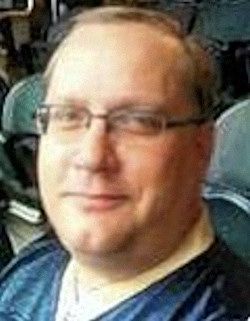 Very sad news ... Terry L. Griffith, Oklahoma City historian and writer of three basic books on Oklahoma City's history, died on Christmas Day 2014.
I never met Terry but his three Arcadia Publishing books have been a constantly used and reliable source of information about our city's history. His obituary was published this morning in the Oklahoman:
Nov 8, 1961 - Dec 25, 2014 OKLAHOMA CITY Terry L Griffith, 53, of Oklahoma City, died Dec. 25, 2014, after a valiant fight with cancer. He was born Nov. 8, 1961, in Oklahoma City, a city he loved and had a passion for. He became a historian on his beloved city, with three published books on the subject. He worked as a barista for Starbucks, where his humor, charm, smiles and laughter will be missed. He is survived by his best friend, Stephen Spottedhorse; cousin, Johnny Hindman; and many loving friends. He was predeceased by his parents, Lee and Magnolia Griffith. Terry is gone from this life but never from our hearts. Memorial service will be held at a later date.
The three books mentioned in the above obituary are:
(1) Oklahoma City: Land Run to Statehood (Arcadia Publishing 1999).
(2) Oklahoma City: Statehood to 1930 (Arcadia Publishing 2000).
(3) Oklahoma City: 1930 to the Millennium (Arcadia Publishing 2000).
I reviewed these books in a much earlier post and no need exists to do so again.
God speed, Terry Griffith. You are missed, and you are thanked for your contributions to our city's history.
Go To Top
... Click here to read the full article and any comments ...
A Book Review by Doug Loudenback
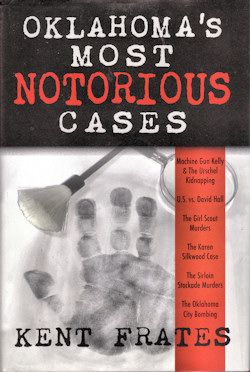
Who doesn’t savor extravagantly entangled murder mysteries, nefarious melodramas in which big business is allegedly unworried about harming the public, and yarns of political corruption-crime-and-intrigue?
I’m not presently thinking of stories like the modern-day Sherlock on PBS, or movies like 1979's The China Syndrome, or Netflix’s House of Cards — as much as I enjoy them all. Right now, I’m thinking, “Ya got trouble, my friend, right here, I say, trouble right here in River City.” We’ve had real true-to-life similar troubles right here in Oklahoma River Cities!
That kind of trouble is what Oklahoma’s Most Notorious Cases is all about. Hereafter, I use “Notorious” to reference the book title. In it, Oklahoma City author Kent Frates chronicles six of those true-story troubles — those befitting his label of “Oklahoma’s most notorious cases.” He identifies them as ...
1. Machine Gun Kelly & the Urschel Kidnapping
2. U.S. v. David Hall
3. The Girl Scout Murders
4. The Karen Silkwood Case
5. The Sirloin Stockade Murders
6. The Oklahoma City Bombing
... and this is my review of and a few notes about Mr. Frates’s book, Oklahoma’s Most Notorious Cases (The RoadRunner Press, Oklahoma City, 2014).
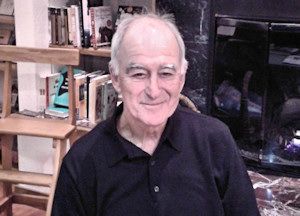 First Booksigning. It was at the Full Circle Bookstore, Oklahoma City, Tuesday, November 11, 2014, at 6:30 p.m. — which is to say, a few days ago. My intention was to have this review done well before then, but that didn’t work out. I should have been too embarrassed to attend, but I sucked it up, attended the booksigning, and got the photo of the author, at the left. Other notable lawyers — (Honest) Don Davis, H.K. Berry, and John Michael Williams — were present while I was there. Probably, other booksignings will occur, and I will update this paragraph as I learn of them. First Booksigning. It was at the Full Circle Bookstore, Oklahoma City, Tuesday, November 11, 2014, at 6:30 p.m. — which is to say, a few days ago. My intention was to have this review done well before then, but that didn’t work out. I should have been too embarrassed to attend, but I sucked it up, attended the booksigning, and got the photo of the author, at the left. Other notable lawyers — (Honest) Don Davis, H.K. Berry, and John Michael Williams — were present while I was there. Probably, other booksignings will occur, and I will update this paragraph as I learn of them.
Booksigning UPDATE! The next booksigning: Saturday, Nov. 29th, 3 - 4:30 p.m.
Best of Books, Kickingbird Square, 1313 E. Danforth Road, Edmond 405.340.9202 (At least I'm on time for this one.)
The Book’s Website:
http://www.okmostnotoriouscases. com/ ... at this website, in addition to purchasing the book, you can read several pages of text in the Girl Scout Murders case and view a few images in the book.
Perhaps because I wrote such glowing words about his June 2014 issue of Common Cause, Kent thought that I would be as generous were I to review his latest literary offering, Oklahoma’s Most Notorious Cases. If he did think that (and he probably didn’t — he is a stand-up guy), he was certainly correct. Having received his October 7 invitation to review his latest book, and having finished my reading and analysis, the briefest review is simply this: I just loved this excellent Oklahoma (primarily Oklahoma City) history book.
Naturally, I am obliged to be more particular and critical in an objectively written book review, so let’s have a closer look.
The Book Itself. This hardback book is 338 pages long, plus 11 pages of chapter notes, plus 16 pages of mostly small but 30 high quality photos on glossy photo paper. That makes the actual page length 365 pages, not including the introductory pages to each chapter four of which begin with a poem penned by Mr. Frates. Paper and print quality are excellent. Graphics quality is also excellent, as shown by the reduced-size scan of two pages below:
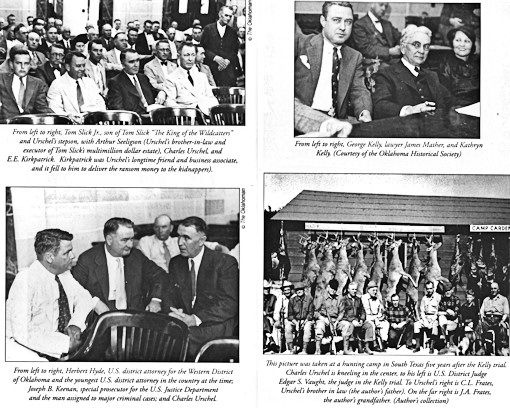 My favorite of the above photos is the lower right hunting trip — Urschel is kneeling in the center and to his immediate right is the author’s father, C.L. Frates — the resemblance between the author and his dad is remarkable.
My favorite of the above photos is the lower right hunting trip — Urschel is kneeling in the center and to his immediate right is the author’s father, C.L. Frates — the resemblance between the author and his dad is remarkable.
The book size is approximately 6" x 9." The price is $24.00 U.S. dollars, $26 Canadian. It is also available at Amazon at a slightly lower price. For a quality hardback history book such as this book is, at any of these prices, it is quite a steal.
Why We Care About The Trouble. In the book’s Introduction, Kent says,
Legal cases are, of course, about events, but they are more about people. They have heros, and they have villains ... sometimes really bad villains. Who the good guys and the bad guys are goes to the heart of any good legal case, or true story. How often has someone picked up the newspaper or turned on the television and asked himself, How could anyone do that? How could anyone be that evil?
It may well be fortunate that we cannot know the thought process of the most vicious criminals, but it would be disingenuous to pretend that their crimes do not catch and hold our attention. As much as we’d like to understand what drives the villains, we are equally, if not more so, enamored by the heroism, resourcefulness, and pure tenacity of the law enforcement professionals who bring down the same criminals. It is somehow this ying and yang of our justice system that creates memorable cases.
In a world of instant news and constant communication we must remember it was not always like this. The shrill buzz of 24/7 coverage is a relatively new phenomenon. Newspaper stores, word-of-mouth accounts, radio bulletins, and early-day television reports spread the news in less graphic and slower ways. Trials remain a source of mass entertainment, but there was a time when people actually traveled from town to town to attend them, as fans might travel for a sporting event. [Emphasis supplied]
Kent didn’t put it this way, but the truth is (I think) that most of us, including me, are voyeurs — we like to watch — and our attention is drawn to both humanity’s dark and light sides at the same time, for whatever reason. We like to watch Darth Vader as much as we do Luke Skywalker.
The Author’s Choices. The preface page to his Introduction contains this definition of “notorious,” doubtless derived from some unnamed dictionary:
Notorious: well-known or famous especially for something bad: generally known and talked of; especially: widely and unfavorably known: from the Latin noscere to come to know
In the Introduction, he amplifies his intended meaning and the reasons he chose the six cases he did from Oklahoma’s (and, largely, Oklahoma City’s) history:
What then makes for a notorious case? Some trials are so universally well known, we simply refer to them as the “Trial of Galileo” or the “Scopes Trial.” But to rise to the level of notorious requires that a case be more than just ubiquitous, think, “Lizzie Borden” or “Charles Manson,” “John Hinckley Jr.,” or “O.J. Simpson.” Such cases carry a hint of evil, an indifference to one’s fellowman not found in your average murderer or corrupt politician or thief. [Emphasis supplied]
* * *
The cases chosen for this book cover a wide swath of Oklahoma history from 1933 to 2004. Some older cases were rejected because of the lack of sufficient reliable records.
Doubtless, the author’s six choices match all of his requisite standards — even though one could make a case for the addition of populist Governor Jack C. Walton, Oklahoma’s fifth Governor, who was impeached by the Oklahoma House of Representatives, and then tried, convicted, and finally removed from office by Senate on November 19, 1923, after serving only eleven months in office. The story of this politician and his career has all the earmarks of being “notorious” — plus, evidence of evil was ample on all sides surrounding his fascinating eleven-month term in office — including Walton’s imposition of martial law, his placement of armed National Guardsmen around and on top of courthouses, even his commandeering The Tulsa World newspaper for a time, his suspension of the writ of habeas corpus and massive corruption in office, as well as the KKK’s involvement both in and out of the Oklahoma Legislature. Other scholars have noted that, most probably, a majority of Oklahoma House and Senate members were members of the KKK during the time of Walton’s tenure as Governor. Although I would have relished reading Mr. Frates’s description of this period of Oklahoma City history, I must give him a pass for not doing so because, after all, Notorious is his book and not mine.
As to Kent’s content choices, I’ll make a few comments, but I’ll spend more time with the first case than the others — partly because I want to illustrate an exemplary case, but also because the Heritage Hills Urschel home is only three blocks from where I live in Mesta Park.
Case #1 — Machine Gun Kelly & The Urschel Kidnapping, Chapters 1-11.
The Kidnapping, Not Your Normal Hostage, The FBI, The Ransom, The Hunt, On the Run, The First Trial, Capturing the Kellys, The Kelly Trial, Aftermath, Kathryn & Ora Set Free
Some sources say that George Francis Barnes Jr. was born on July 18, 1895, in Memphis, Tennessee — Notorious says that he was born on July 14, 1900, in Chicago, Illinois. Either way, he changed his name to George R. Kelly and came to be popularly known as Machine Gun Kelly. He died on July 18, 1954, in Leavenworth, Kansas. His last wife, Kathryn, co-conspirator and probable planner of the kidnapping but not present when it occurred, was born Cleo Mae Brooks in Saltillo, Mississippi, in 1904. A third principal bad guy and participant in the actual kidnapping was Albert Bates, born October 16, 1893.
About Kathryn, Notorious notes that J. Edgar Hoover said, in his 1938 book, Persons in Hiding:
Several years ago, thousands of our citizens shivered in fear of a kidnapper whose name had much to do with the terror he engendered: he was called Machine-gun Kelly. However, there was someone far more dangerous than Machine-gun Kelly. That was Machine Gun Kelly’s wife.
Anecdotally, I’ll mention that another lawyer friend of mine, John Brewer of Oklahoma City, whose father had been married to Kathryn before she married Kelly, related to me that Charles Urschel may have been an afterthought concerning their pending kidnapping. He says:
Some time prior to the Urschel kidnapping, Kathryn and George showed up in Pauls Valley [Oklahoma] with the intention of kidnapping my older brother. A hotel employee overheard the plotting, told my dad, and my dad told the local sheriff. Kathryn and George were told to leave town. Urschel was next in line. Actually Urschel was MUCH better off financially than my dad.
The actual victim-in-waiting proved to be Charles F. Urschel. He lived in Oklahoma City at 327 N.W. Eighteenth Street with his second wife, Berenice. Urschel was born in Hancock County, Ohio, on March 7, 1890, and died on September 16, 1970, in San Antonio, Texas.
Frates doesn’t quantify Urschel’s wealth, but he does note that the Cushing oil field was developed by Urschel and Tom Slick and that, in 1919, “it accounted for seventeen percent of the United States and three percent of world production of oil.” Think about that for a moment — 17% of oil production in the United States and 3% of the world’s. That’s one heck of a lot of o’ earl!
The pair continued their business partnership until Slick died in 1930, leaving Bernice as his widow. After Urschel’s first wife died in 1931, Charles married Berenice, Slick’s widow, thereby combining their vast fortunes.
 The author describes the Urschel home as a “mansion,” and indeed it was, and it so remains. The Oklahoma County Assessor’s records state that the home contains 6,330 square feet. This photo was taken October 2014. The Oklahoma City Historical Preservation Commission’s marker on NW 18th states that it was built in 1923, was originally owned by Tom Slick, and would later be owned by US Senator Robert S. Kerr. The author describes the Urschel home as a “mansion,” and indeed it was, and it so remains. The Oklahoma County Assessor’s records state that the home contains 6,330 square feet. This photo was taken October 2014. The Oklahoma City Historical Preservation Commission’s marker on NW 18th states that it was built in 1923, was originally owned by Tom Slick, and would later be owned by US Senator Robert S. Kerr.
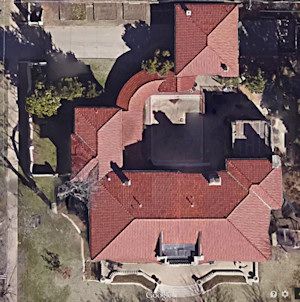 This view from Google Earth shows the spacious mansion from the air. This view from Google Earth shows the spacious mansion from the air.
While playing a late-night hand of bridge within the above home’s screened back porch on July 22, 1933, at 11:15 p.m., Urschel and, initially, his friend Walter Jarrett, were abducted — Jarrett was released some hours later in eastern Oklahoma County once the abductors managed to figure out which of the pair was actually Urschel, the intended target of the kidnapping. A $200,000 ransom was demanded, paid, and, eventually, somewhat recovered. The author notes that the sum would be the equivalent of about $3,000,000 in today’s currency. He deliciously takes his readers through the lives of the people and events surrounding the first FBI kidnapping case and the first criminal trial to occur in Oklahoma City’s then new federal courthouse — quite possibly setting a land speed record for “speedy trial.”
These comments just skim the surface of this fascinating case — and, no, Kelly did not coin the phrase, “G-man,” as in, “Don’t shoot, G-man.” Most probably, that phrase can be attributed to Hoover and his then infant FBI organization.
Many internet sources exist for the events described in this Notorious case, but given that (1) the author’s research is extensive, and (2) he is a nephew of Charles and Berenice Urschel and communicated with Charles about it before his death, my expectation is that the author’s accounts are the most accurate of all available.
Case #s 2-6. This review is already too long so I’ll make fewer comments about the other cases in Notorious, below.
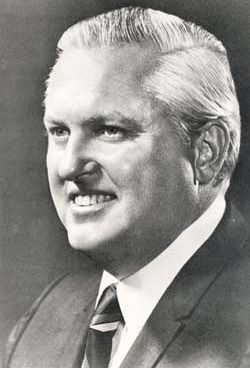 Case #2 — United States v. David Hall, Chapters 12-24. Case #2 — United States v. David Hall, Chapters 12-24.
The Road To Success, Politics, Governor Hall, Kickbacks, Bribes & The IRS, Political Defeat, Wired, The Sting, The Payoff, Federal Charges, The Trial, The Defense, Guilty, Payback & Denial
This case describes the legacy of the 20th Governor of Oklahoma (1/1/1971 - 1/13/1975). It is a story of money, bribery, kickbacks, and extortion, all wrapped up in a governor’s clothes. It tells the story of what can happen when blind ambition is coupled with very shallow pocketbooks in the power of the office of the Governor of Oklahoma. Near the end of his term in office, Hall was already the subject of federal grand jury proceedings — but the Fall 1974 investigation didn’t end there. Amazingly, Hall engaged in one of his most arrogant schemes during his last 1½ months in office, he knowing all the while that he was under intense scrutiny by federal authorities.
On January 13, 1975, he served his last day in office. Three days later he was indicted on four counts in federal court involving extortion, conspiracy to use interstate commerce to carry on an unlawful activity, and bribery. His trial began on February 24 and the jury was given its instructions on March 12. On March 14, verdicts of guilty were returned on all counts. All appeals failed and, after serving only 18 months of his 4-year sentence, he was released from federal prison. He and his wife are living out the remainder of their lives in southern California, Hall still professing his innocence.
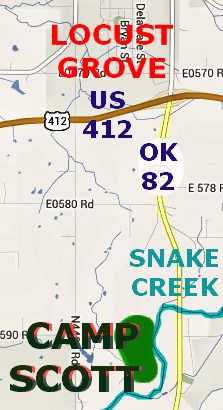 Case #3 — The Girl Scout Murders, Chapters 25-37. Case #3 — The Girl Scout Murders, Chapters 25-37.
The Crime, The Investigation, Gene Leroy Hart, Manhunt, Homeboy, Captured, The Prosecution, Preliminary Hearing, Newly Discovered Evidence, The OSBI Reports, The Trial, The Defense, Controversy
Late night, on June 13, 1977, three young Girl Scouts camping at Camp Scott south of Locust Grove in Mayes County were sexually molested and brutally murdered. They were Lori Lee Farmer (8 years old), Michelle Heather Guse (9), and Doris Denise Milner (10).
This is the only case in Notorious which does not have a metropolitan Oklahoma City venue.
That said, the only person ever charged with the murders, James Leroy Hart, was defended by a then-young Oklahoma City lawyer, Garvin Isaacs, who would make his name on this case.
 This case is as much a description of inept investigation and prosecution as it is with the only person charged with these brutal crimes — Gene Leroy Hart — who was eventually charged and acquitted. The author notes at the outset: This case is as much a description of inept investigation and prosecution as it is with the only person charged with these brutal crimes — Gene Leroy Hart — who was eventually charged and acquitted. The author notes at the outset:
When a heinous crime occurs, and a suspect is charged and later found not guilty, public doubt always persists as to whether the defendant did or did not commit the crime. This is especially true when no other suspects emerge and no one else is ever charged with the crime. Such a case marks a failure by law enforcement. Either a guilty person was somehow acquitted, or the real perpetrator of the crime has not been found. In either event, the person who committed the crime goes free. It is this controversial result that marked the conclusion of what became known nationwide as “The Girl Scout Murders.”
Hart was a primary suspect from the beginning of the investigation. He was an escaped convict and grew up in the area where the crimes occurred. He was also a Cherokee Indian, and the author describes how that fact played into the mix. The trial began on March 5, 1979, and jury deliberations began at noon on March 29. By 10 a.m. the next day, the jury had reached a unanimous verdict of not guilty. On June 4, 1979, Hart died of a heart attack while in prison for earlier offenses.
If Hart was guilty, very clearly the state — investigators, local sheriff, OSBI, and lawyers, had not done their collective job. The author notes, at page 146:
Later, jurors would say they had believed there was “manufactured evidence” and that “the investigation was a screwed-up mess.”
Although the science of DNA testing did not exist at the time of the Hart trial, three post-trial attempts to determine DNA matching, in 1989 or so, 2002, and 2008, were inconclusive.
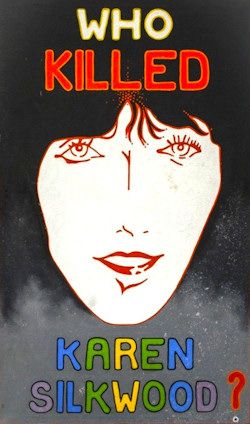 Case #4 — The Karen Silkwood Case, Chapters 38-49. Case #4 — The Karen Silkwood Case, Chapters 38-49.
Unlikely Adversaries, The Union, Contamination, The Fatal Accident, Accident Reconstruction, Headlines, The AEC, The FBI, & Congress, Silkwood v. Kerr-McGee, The Trial, The Plaintiff’s Case, The Defense, Appeal, Reversal, & Settlement
This is the only case presented in Notorious that did not involve a criminal trial — but it did involve a high profile civil suit brought by the surviving members of Silkwood’s family against Kerr-McGee, the then mainstay energy company in Oklahoma. It was filed in the U.S. District Court for the Western District of Oklahoma on the grounds of negligence — gross and ordinary — and strict liability in tort due to an allegedly inherently dangerous substance — plutonium.
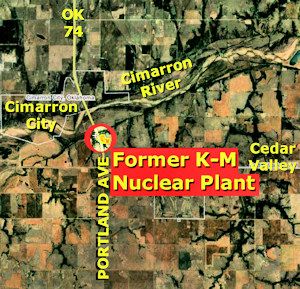 Inexplicably, Kerr-McGee denied that plutonium was an inherently dangerous substance and its denial opened the door for the plaintiffs to offer evidence that — duh — plutonium was an inherently dangerous substance and to prompt the plaintiffs’ often-mentioned mantra during trial that, “If the lion gets away, Kerr-McGee must pay.” Inexplicably, Kerr-McGee denied that plutonium was an inherently dangerous substance and its denial opened the door for the plaintiffs to offer evidence that — duh — plutonium was an inherently dangerous substance and to prompt the plaintiffs’ often-mentioned mantra during trial that, “If the lion gets away, Kerr-McGee must pay.”
Karen Gay Silkwood was born February 19, 1946, in Longview, Texas, and died on November 13, 1974, along OK 74 located south of the Cimarron River and of Crescent, and north of Oklahoma City on the same road which becomes Portland Avenue and the Lake Hefner Parkway in Oklahoma City.
Shortly before and certainly after her death, Silkwood became a cause célèbre for labor, women’s rights, and anti-nuclear movements. The events even spawned a fine movie, Silkwood, a Mike Nichols film starring Meryl Streep as Silkwood, Kurt Russell, and Cher. Notwithstanding how public perception may have come to view and/or mold her legacy, she was not opposed to the nuclear energy industry in the United States, but she was concerned about labor and safety issues. Silkwood’s job at the Cimarron plant was to create plutonium pellets and load those pellets into long, stainless steel rods, and no information is presented indicating that she had any objection to those assignments.
How and/or why did she die? Was it because she was a whistle-blower concerning Kerr-McGee’s safety practices? Ultimately, the question became, what was Kerr-McGee’s culpability in causing her death?
On November 13, Silkwood drove from the Kerr-McGee plant southbound on OK 74 toward Oklahoma City when her car veered off the road and crashed, the crash causing her death. It was said that she was on her way to a meeting with a reporter for the New York Times and was carrying evidentiary documents harmful to Kerr-McGee. Those documents, if any there were, were never to be found.
Some surmised that her vehicle struck was from the rear, forcing her car to careen off the road — one accident reconstruction expert surmised that the scenario was at least possible or even likely. Or was she under the influence of drugs or otherwise fell asleep, causing her own death? Was the plutonium contamination found in her residence placed there by Silkwood or planted there by Kerr-McGee?
The federal court litigation had high-powered lawyers all around and Kent explores them all very nicely. Without getting into much detail here, the case went to the jury and it returned a verdict for $5,000 property damage, $500,000 for personal injuries, and $10,000,000 for punitive damages. Very evidently, the jury bought the substance of the plaintiffs’ case. But, on appeal, the 10th Circuit Court of Appeals determined that the issue of personal injuries should have been pursued in Oklahoma Worker’s Compensation Court and the personal injuries award was vacated as was the $10,000,000 punitive damage award — only the $5,000 property damage award was affirmed. The U.S. Supreme Court accepted further review, and it determined that the 10th Circuit was wrong in vacating the punitive damage claim and the issue was remanded (sent back) to the 10th Circuit, which, in turn, sent the matter back to the trial court for retrial, five years after the original verdict.
Rather than undergo another expensive and lengthy trial, in August 1986, the parties reached a compromise and Kerr-McGee agreed to pay $1,380,000 for a settlement of all claims.
Even today, this being the 40th anniversary of Silkwood’s death, her case is the subject of retrospective analysis and controversy. As examples, see the October 28, 2014, issue of County Line Magazine, and the November 10, 2014, issue of The Tulsa World.
Case #5 — The Sirloin Stockade Murders, Chapters 50 - 61.
The Crime, The Investigation Begins, The Lorenz Case, The Guns, Getting a Break, Roger Dale Stafford, Lawyered Up, The Trial, Roger Dale Takes the Stand, The Death Penalty, The Lorenz Trial, Verna
On Sunday night, July 16, 1978, the bodies of six employees at the Sirloin Stockade restaurant, 1620 S.W. 74th Street, Oklahoma City, were discovered in the restaurant’s small walk-in freezer, all shot. All but one was dead and she died later that evening. They were Terri Horst (age 15), David Salsman (15), David Lindsey (17), Anthony Tew (17), Isaac Freeman (56), and Louis Zacarias (43). Almost a month earlier, on June 22, 1978, a passing motorist discovered the bodies of Air Force Sgt. Melvin Lorenz (38) and his wife, Staff Sgt. Linda Lorenz (34). The body of their twelve-year old son, Richard, was found the next day. All had been shot dead about two miles south of Purcell, Oklahoma, near the northbound lanes of Interstate 35. While driving from San Antonio to Fargo, North Dakota, to attend Melvin’s mother’s funeral, they stopped to offer assistance to motorists whose car was apparently disabled, but instead of helping the stranded motorists, they were murdered by them.
In all these murders, the same people, Roger Dale Stafford, his wife Verna, and his brother, Harold, were the killers, but that was anything but evident at the outset. Early on, linkage between the pair of killings was not evident, and the identity of the killers was a mystery without leads.
If the Girl Scout Murders case serves to illustrate poor police work and prosecution, this pair of group homicides represents the other side of the coin. As to the Sirloin Stockade case, the author says,
No rational motive existed for the killings, and no obvious suspects could be identified. Solving the murders had to be accomplished the old fashioned way, by intense and thorough police work. The officers involved deserve credit for cracking the case, though the big break came compliments of the bizarre personality of the killer, Roger Dale Stafford.
Stafford’s brother, Harold, died in a motorcycle accident six days after the Oklahoma City killings; after all his appeals failed, Roger Dale died on July 1, 1995, by lethal injection in the Oklahoma State Penitentiary in McAlester, Oklahoma; and Verna is living in the Mabel Bassett Correctional Center in McLoud while serving the early part of her eventual sentence — two consecutive life terms.
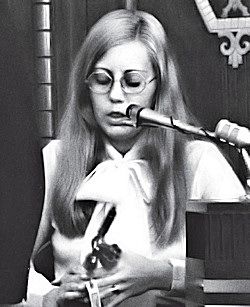 A subchapter title in this case might have been Verna Rae Stafford vs. Roger Dale Stafford, husband and wife. Roger had apparently counted on her not being able to testify against him, but a change in Oklahoma law was interpreted by the courts as allowing her testimony. A subchapter title in this case might have been Verna Rae Stafford vs. Roger Dale Stafford, husband and wife. Roger had apparently counted on her not being able to testify against him, but a change in Oklahoma law was interpreted by the courts as allowing her testimony.
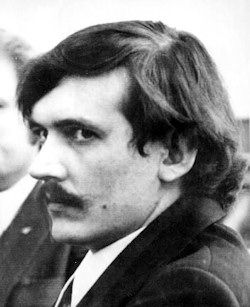 The author reports on Roger Dale being interviewed/questioned by Arthur Linville, OSBI agent, as follows: The author reports on Roger Dale being interviewed/questioned by Arthur Linville, OSBI agent, as follows:
When Linville advised Roger Dale that she [Verna] could indeed testify against him, Roger Dale was visibly shaken.
“Man, I can’t think. I’ve got to think. All I can see is the gas chamber,” he said.
Verna’s cooperation with the prosecution doubtless facilitated the state’s case, even though much other evidence was presented at Roger Dale's trials other than his wife’s testimony — not the least of which was Roger Dale’s own testimony. He evidently considered himself as possessing an unerring ability to talk himself out of anything and he apparently insisted on waiving his right against self-incrimination and testifying to the juries in both the Sirloin Stockade and Lorenz murder trials. That didn’t work out — he received six death sentences in the Oklahoma City and three in the Purcell trials.
Doubtless, Verna hoped for leniency when her own participation in the murders was decided, following Roger Dale’s death sentences. Initially, in a plea agreement between the prosecutors in both cases and her attorney, she received an indeterminate sentence of 10 years to life. However, the author states at page 249:
In an unrelated case, the Oklahoma Court of Criminal Appeals had ruled that a court could not set an indeterminate sentence in a case in which a life sentence was the maximum imposed. Based on this decision, Verna moved to set aside her sentence and be resentenced to ten years which, given time served, would have allowed her to go free immediately.
Her resentencing hearing was assigned to Oklahoma County District Judge Richard Freeman. The judge correctly set aside Verna’s original sentence but then proceeded to conduct a hearing in which both parties offered evidence.
* * *
At the close of the evidence, Judge Richard Freeman hammered Verna with two life sentences to be served consecutively, effectively meaning she would have to be paroled twice to ever have a chance to get out of prison. Judge Freeman told Verna, “I would wager that there’s one of the hottest corners of hell vacant with your name right above it.”
The author spins the true tale of these two groups of grizzly murders, step by step, inch by inch, in a darkly fascinating and unfolding drama. Any number of interesting items could be mentioned, e.g., Roger Dale’s Oklahoma City trial was the first trial in Oklahoma to be broadcast on television.
The above killings were the worst to occur on Oklahoma soil, but that would change on April 19, 1995.
Case #6 — The Oklahoma City Bombing, Chapters 62-79.
Where Were You, McVeigh & Nichols, Waco, The Plot, Leaving a Trail, Building the Bomb, The Crime, The Arrest, The Investigation, The Arrest of Nichols, McVeigh’s Lawyer, The Legal Battle Begins, The Trial, The Defense, The Case Against Nichols, Nichols’s Defense, State of Oklahoma v. Nichols, Conspiracy Theories
Candidly, this is one case about which I did not want to read. I can answer the question, “Where Were You,” posed by the author’s first sub-chapter in this case. . I can answer the question, “Where Were You,” posed by the author’s first sub-chapter in this case. I was downtown in the first floor of the Oklahoma County Courthouse on Friday, April 19, 1995, at 9:02 a.m., sitting in the jury box of Judge Clinton Dennis’s courtroom as he was beginning to call his regular Friday morning motion docket. Rather than elaborate on my personal experience further, allow me to say that the cases of the Murrah Bombing, Timothy McVeigh, Terry Nichols, the 168 murdered victims, including 19 babies and older children, and another 680 who were injured, and the trauma that all Oklahoma Citians suffered and endure through this day, are not things that I willingly recall, even now, almost 20 years later. I’ve never written on the topics in Doug Dawgz Blog, and, aside from these brief paragraphs, I never will.
Gladly, the author’s “just the facts, ma’am,” approach keeps a reading of this case from becoming teary, and that method pleased me greatly. A very tough and sensitive subject was handled brilliantly, and that’s all I have to say about that.
Mastery of Content. Notwithstanding my mild criticism of his Notes section, below, Mr. Frates’s research and command of the subject matter of his book are plainly evident. Meticulously, he pieces together each facet of the six cases with amazing ease — a task which could not be done without a deservedly confident knowledge that he had done his research well and thoroughly. The Notes section reflects his review of media reports, trial transcripts, appellate case decisions, interviews with defense and prosecuting attorneys, and more. In the Machine Gun Kelly & Urschel Kidnapping case, he even relates conversations with Charles Urschel, the man kidnapped who also happens to be the author’s uncle.
Writing Approach and Style. In describing how he formed the book’s title, Kent says, “For a lawyer, a straightforward statement is usually the best way to communicate,” adding, “That’s not necessarily true for writer of history.” Although I am uncertain about how he would differentiate between the two, his use of simple words, short sentences, short paragraphs and chapters, and straightforward language in fitting together the often-complicated pieces of each of the six cases’ puzzles results in an exceptionally easy to read masterpiece of story telling. By comparison, not one of his sentences are as complicated as the compound sentence I’ve just written. Not once did I need to re-read a sentence to understand what the author just said.
Each of the six cases in Notorious are broken into a varying number of context-driven chapters for each of the six cases. By “context-driven,” I mean “subtopic” — e.g., in the Machine Gun Kelly & The Urschel Kidnapping case, the chapters are “The Kidnapping,” “Not Your Normal Hostage,” “The FBI,” “The Ransom,” “The Hunt,” “On the Run,” “The First Trial,” “Aftermath,” and “Kathryn & Ora Set Free.” One might say that each chapter represents one large piece in the overall legal puzzle. By the use of such chapter subtopics, a reader understands what piece of the puzzle is being described and no need exists to have a strictly lineal timeline since multiple pieces of the puzzle may well be occurring simultaneously — much like a modern-day movie would do.
The chapters are short, ranging from three to eight pages with three-to-four pages being the norm. Coupled with what I already said — that sentences are short and easy to read — each case story flows easily and quickly and, before you know it, the book is done.
In addition to his content mastery, Mr. Frates’s writing style garners my highest compliments. It is no small task to take a complex case, regurgitate it, and then parcel it into coherent, brief, and easy-to-read subtopic-chapters — and do that six times — a task which the author brilliantly accomplishes.
Criticisms. I have just a few ...
No Index. Academically, I criticize any history book that does not contain an index at its end — maybe that’s just me or my view of good scholarship. Even though I’m hard-pressed to see how an index would add a great deal that the book’s very descriptive table of contents fails to provide, still, I note that Notorious contains no index.
The Notes. As a reader of history, I like specific endnotes or footnotes within the text as the author tells his/her story. That way, I can follow up to the referenced note and check out the source and/or read more from that identified source than the author provided, if I want. Although an 11-page Notes section does exist at the end of Notorious and is fairly extensive, my preference is that actual endnote numbers be used within the text of the book which link to particular notes identified in the closing Notes section.
Moreover, in the Notes section, the word “chapter” is used to refer to a particular case, e.g., “Chapter 2, The United States of America v. David Hall,” as opposed to the “chapter” usage which appears in the book’s body which range from chapter 1 through chapter 79. In this example, the David Hall case was identified as chapters 12 through 24 which are collectively identified as “Chapter 2” in the Notes section.
Last, on occasion, the Notes section is date specific, sometimes not — e.g., referencing the David Hall case, the author notes that personal interviews occurred with three individuals by name and date, but sometimes other sources are not as particularly identified, such as when referencing “Newspapers” — the names of the newspapers (Oklahoma City Times, The Oklahoman, San Diego Union, Tulsa World) are mentioned but no particular articles are identified by byline or by date or in what context and/or literal chapter they might relate to. In the David Hall case, literal chapter numbers are from chapter 12 through chapter 24 — but the Notes section is unspecific in such regards.
Summary. This is one of the most thorough, easy to read, substantive, and, yes, finest books on Oklahoma (and Oklahoma City) history that I’ve had the pleasure to read. It is also inexpensive. Its content is well-chosen. It is easy to read. The book production quality is excellent in all respects. Only in its lack of an index, and footnotes or endnotes within the text, coupled with more particular note identification in the book’s Notes section, does any shortcoming exist. In balance, these criticisms are not sufficient to cause me to lower my esteem for this book from 5-stars, my highest rating, to any lower number. Notorious is a 5-star book. It is a must buy for any lover of Oklahoma City, as well as Oklahoma’s, history.
The Book’s Website: http://www.okmostnotoriouscases.com/
Full Circle Purchase: Click here Amazon description/purchase: Click here
The author's biography: click here
Go To Top
... Click here to read the full article and any comments ...
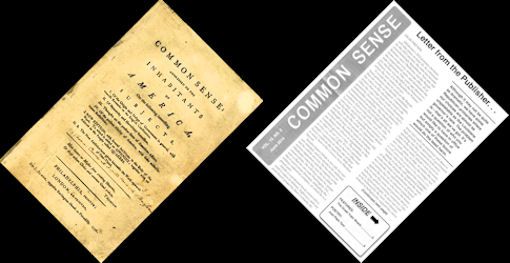
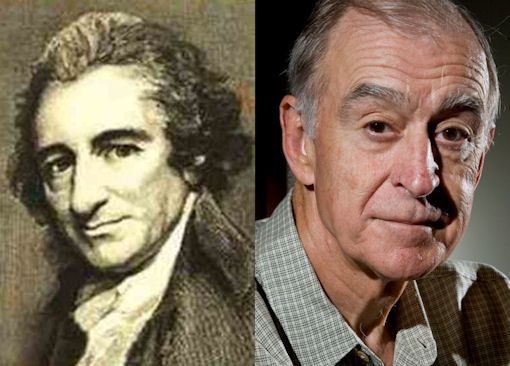
What do the venerable Thomas Paine, author of the 1775-1776 pamphlet, Common Sense, and modern day Oklahoma Citian, lawyer, former Republican legislator, and author, Kent F. Frates have in common?
They both had/have common sense. Read on, concerning the upcoming June 24 primary elections in the state. I promise you, Mr. Frates' observations will literally "leave you rolling on the floor laughing," be you a Republican (as he is) or Democrat (as I am) — as well as being chilled sober, all at the same time. If you are a "modern-day" Republican, as opposed to a Henry Bellmon or a Frank Keating Republican, you will probably not find his opinions so humorous. Latter-day Republicans will probably not like his torpedo salvos of Common Sense into the upcoming elections, even though those salvos hit the mark every time.
About Kent Frates.
I've known Kent since I worked in his law firm in the mid-to-late 1970s, back in the day that I was still a registered Republican. In that time, Kent was a Republican member of the Oklahoma House of Representatives, representing the Nichols Hills area, and was once the (then Republican) minority leader in the house. I recall helping post yard signs in that time for his reelection. I recall very well Kent's adroit sense of humor on a daily basis, his keenness of mind, and his willingness to be his own brand of what it meant in that time to be a Republican. That willingness has evidently not changed. He received his undergraduate degree at Stanford and his law degree at the University of Arizona. For his full resume, click here for a PDF file showing the same.
But Kent is much more than what those links and biography show. He is a modern-day Thomas Paine Common Sense kind of guy. If you doubt that, read on to read his June 2014 issue of Common Sense, his periodical newsletter. All boxed highlights are those shown in the original and I have done no editing. In the newsletter, it is stated,
Common Sense is solely published by Kent F. Frates. If you would like to receive or discontinue this publication, or if you have any submissions for or comments about this publication, please write to: Kent F. Frates, P.O. Box 54799, Okla. City, OK 73154. Reproduction in any form of this publication is a violation of copyright law and is prohibited without permission from Kent F. Frates, publisher. Copyright © June 2014.
Mr. Frates has kindly allowed that I reproduce the lead article in the June 2014 Common Sense publication, below.

Letter from the Publisher ...
Dear Friends,
Oklahoma's 2014 Primary Elections will take place on June 24th. As witnessed by the 2012 election, the state has become overwhelmingly Republican. Not only did Romney carry Oklahoma but, the Republicans swept every statewide office, all of the congressional seats and, dominated the state legislature. Fifty years ago almost every election was decided in the Democratic Primary, now it is the Republican Primary where the real contest occurs.
It would be nice to analyze the Republican Primaries and, identify candidates that are worthy of support. Unfortunately, the voters in this election are faced with choices that range from weak to disastrous. Often the voter will have to exercise a fool's gambit by choosing between two distinctly undesirable candidates. The situation is reminiscent of an election for Governor in Louisiana between David Duke and the incumbent, Edwin Edwards. Edwards who had been charged with crimes and was later convicted, faced Duke, a proud member of the Klu Klux Klan.
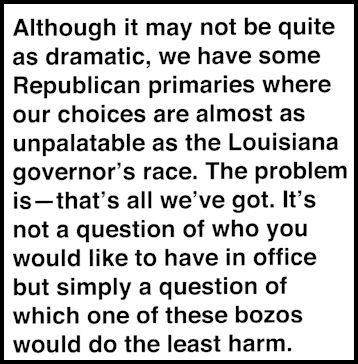 A popular bumper sticker read "Vote for the crook, it's important", and that's what the people of Louisiana did. Although, it may not be quite as dramatic, we have some Republican Primaries where our choices are almost as unpalatable as the Louisiana governor's race. The problem is — that's all we've got. It's not a question of who you would like to have in office but simply a question of which one of these bozos would do the least harm. With that in mind, here is the Common Sense Election Special.
A popular bumper sticker read "Vote for the crook, it's important", and that's what the people of Louisiana did. Although, it may not be quite as dramatic, we have some Republican Primaries where our choices are almost as unpalatable as the Louisiana governor's race. The problem is — that's all we've got. It's not a question of who you would like to have in office but simply a question of which one of these bozos would do the least harm. With that in mind, here is the Common Sense Election Special.
Senator James Inhofe is too old, too narrow-minded and, too dumb to be reelected but, he will be anyway. He has drawn no serious opposition and the majority of the Oklahoma voters buy into his so called conservatism. He will thus retain his senate seat so that he can roam Washington D.C. like a carnivorous dinosaur, defending the military industrial complex of which he is a proud part.
Inhofe is a professed fiscal conservative, until it comes to defense, highways and, any pork barrel project he likes. Certainly defense and roads are important and deserve high priority in the spectrum of government spending but, they cannot be held sacrosanct if the federal government is ever to achieve fiscal sanity. Inhofe's love for every new tank, plane or, ship, no matter the cost, can't possibly help balance the budget but, it will fatten the pocket of the defense contractors who love to support his campaign.
Inhofe is also the self-appointed leader of those that dispute the fact that the manmade emissions of greenhouse gasses affect climate. His opposition is not based on science but, on an inherent prejudice against the scientists who have the temerity to raise this issue and paranoia about a left wing global warming conspiracy. Like many ignorant people, he does not want to be bothered by the facts and chooses instead to belligerently support his views by attacking the messenger. His arguments are laced with biblical references, misinformation and ridicule. What he really fears are some of the proposed solutions to global warming, like cap and trade. So, rather than looking for a better solution, he tries to deny the existence of the problem. Inhofe has four candidates facing him on the Republican ballot — all are obscure unknowns with no financial backing and no campaign. This is a discredit to the Republican Party in Oklahoma. At least, he votes correctly a lot of the time.
 In the race for Tom Coburn's vacated United States Senate seat, there are three significant Republican candidates who are far right, further right and, furthest right. Congressman James Langford is by any measure a conservative on every issue but, he isn't pure enough for T.W. Shannon who also doesn't quite measure up to Tea Party standards, according to Randy Brogdon. Recently, the three candidates took part in a faux debate before a conservative forum. From the looks of the crowd, the gathering was composed almost entirely of older white people. One of the first questions asked was the position of each candidate on the U.N. All three quickly agreed that the U.S. should get out of the UN. Brogdon, in order to distinguish himself as the rightest of the right, also opined that the U.S. should throw the UN out of the country. These guys are living in another century, yet one of them will be your United States Senator, whether you like it or not. It moves me to shed a crocodile tear for Tom Coburn, an intelligent, independent and thoroughly committed public servant who is unfortunately stepping down from the Senate. In the race for Tom Coburn's vacated United States Senate seat, there are three significant Republican candidates who are far right, further right and, furthest right. Congressman James Langford is by any measure a conservative on every issue but, he isn't pure enough for T.W. Shannon who also doesn't quite measure up to Tea Party standards, according to Randy Brogdon. Recently, the three candidates took part in a faux debate before a conservative forum. From the looks of the crowd, the gathering was composed almost entirely of older white people. One of the first questions asked was the position of each candidate on the U.N. All three quickly agreed that the U.S. should get out of the UN. Brogdon, in order to distinguish himself as the rightest of the right, also opined that the U.S. should throw the UN out of the country. These guys are living in another century, yet one of them will be your United States Senator, whether you like it or not. It moves me to shed a crocodile tear for Tom Coburn, an intelligent, independent and thoroughly committed public servant who is unfortunately stepping down from the Senate.
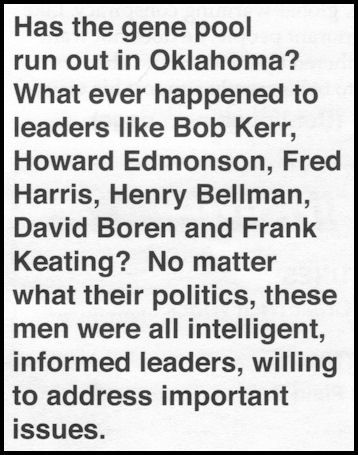 Has the gene pool run out in Oklahoma? What ever happened to leaders like Bob Kerr, Howard Edmonson, Fred Harris, Henry Bellmon, David Boren and Frank Keating? No matter what their politics, these men were all intelligent, informed leaders, willing to address important issues. It is depressing that we have apparently dumbed down our state to the point where candidates like Langford, Shannon and Brogdon are the best we have to offer. But the Legislature wants to be sure we don't make third graders actually learn to read. It might threaten the future of the political class. Has the gene pool run out in Oklahoma? What ever happened to leaders like Bob Kerr, Howard Edmonson, Fred Harris, Henry Bellmon, David Boren and Frank Keating? No matter what their politics, these men were all intelligent, informed leaders, willing to address important issues. It is depressing that we have apparently dumbed down our state to the point where candidates like Langford, Shannon and Brogdon are the best we have to offer. But the Legislature wants to be sure we don't make third graders actually learn to read. It might threaten the future of the political class.
Brogdon seems to have no real chance of being elected. As between Langford and Shannon, however, Langford appears the clear choice. When elected to congress, there were concerns that he lacked the background and experience to serve effectively, given that his life's work had been as an administrator at a Baptist Youth Camp. He was also a Baptist preacher and there was a danger that he would be another aggressive theocrat. In fact, Langford has served, for the most part, effectively. He has proven to be a savvy politician and in some cases, has actually voted for the good of the country, instead of pandering to the extreme right. His position on financial matters is conservatively sound. He is ultra conservative on social issues but does not appear to be obsessed with forcing his views on every citizen through legislation. In most years, Langford would be an extremely poor choice but the level of his opposition makes him look good, in spite of himself.
Shannon has a reputation for mediocrity, and a penchant for political pandering. As Speaker of the Oklahoma House of Representatives, he supported and appeased the extreme social conservatives, while at the same time playing to the Chamber of Commerce crowd. Most recently he advocated making the gross production tax loophole permanent for the benefit of the oil and gas business — a move clearly calculated to help raise funds for his senate race. In spite of being a lawyer, he also tried to pass legislation politicizing the judicial process after the Oklahoma Supreme Court declared one of his pet bills unconstitutional. He also advocates doing away with the E.P.A. If you have any doubt about Shannon's politics, consider that he sought, obtained and, publicizes the endorsement of Sara Palin, the national joke that won't go away.
Based on recent poles [sic, polls], it appears that Langford and Shannon are running neck and neck and that their race is headed for a runoff. If elected, Shannon may well become a right wing demigod following in the footsteps of Ted Cruz. At least Langford won't embarrass the state of Oklahoma, too much.
A sidelight to the Senate campaign is the injection of hundreds of thousands of dollars from "dark money" groups backing both Shannon and Langford. These are entities formed under our obviously flawed election laws where contributions may be made totally anonymously. This sets up a situation where these groups can attack a candidate with vicious irresponsibility and the person they are supporting can profess total ignorance. This despicable charade cheapens the election process and avoids accountability.
The Supreme Court's wrongheaded decision in Citizens United case allows an unlimited flood of corporate money into campaigns, but surely the voters are at least entitled to know where the money is coming from. Maybe if a candidate accused his opponent of taking money from the Russian Mafia, it would force a disclosure of the real source of funds. Congress and the Oklahoma Legislature should act to force a full disclosure of all campaign contributors.
When it comes to Governor, the outcome looks like a foregone conclusion. Mary Fallin defines mediocrity. Yet she is a master politician, having been elected to the offices of state representative, lieutenant governor, congresswoman and governor. Her success is based on an ability not to commit to anything controversial and to be able to change sides effortlessly, if public opinion demands it. Witness her position on accepting an expansion of Medicare and taking federal funds associated with Obamacare and, then, flopping to the other side when the political wind blew the wrong way. Also, her about face on Common Core. She was for it, until she was against it. She exemplifies that old political saying: "I have friends on both sides and I am sticking with my friends." Although, in a rare instance of independence, she did stand up against the unfortunately successful attempt to effectively destroy Oklahoma's third grade reading test.
Fallin has also mastered the special interest game which gives her the ability to raise large amounts of campaign funds. She is a cheerleader and errand girl for the Chamber of Commerce and the oil business, as witnessed by her recent push to lower taxes and to perpetuate the tax loophole for the oil and gas business in the gross production tax. Her latest "successful" lowering of the income taxes resulted in a 0.25% reduction so small to the ordinary tax payer as to be insignificant. Her pro-business stance is good for the state but her propensity to dodge controversial issues leaves a leadership void at the top.
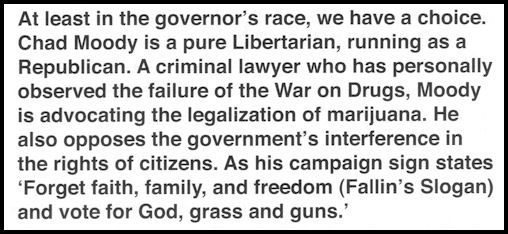 At least, in the governor's race, we have a choice. Chad Moody is a pure Libertarian, running as a Republican. A criminal lawyer who has personally observed the failure of the War on Drugs, Moody is advocating the legalization of marijuana. He also opposes the government's interference in the rights of citizens. As his campaign sign states "Forget faith, family and, freedom (Fallin's Slogan) and vote for God, grass and guns." Common Sense urges you to vote for Chad Moody, our only endorsement in this lackluster primary election. At least, in the governor's race, we have a choice. Chad Moody is a pure Libertarian, running as a Republican. A criminal lawyer who has personally observed the failure of the War on Drugs, Moody is advocating the legalization of marijuana. He also opposes the government's interference in the rights of citizens. As his campaign sign states "Forget faith, family and, freedom (Fallin's Slogan) and vote for God, grass and guns." Common Sense urges you to vote for Chad Moody, our only endorsement in this lackluster primary election.
In the race for U.S. Congress in the fifth district you can't tell the players without a program. The seat was left open when Langford decided to run for the Senate. There are six Republicans, three Democrats, one Libertarian and one Independent. Four of the Republicans — Shane Jett, Clark Jolley, Steve Russell and, Mike Turner — and one of the Democrats, Al McAffrey, are current or former state senators or representatives. Patrice Douglas serves on the Corporation Commission and was formerly the mayor of Edmond.
All of the Republicans are pro-life, against gun control, and hate Obamacare. Although none of the candidates seem remarkable, Jolley has been an effective Legislator. Chairman of the Senate of Appropriations Committee, he has considerable clout. He has also authored a number of significant pieces of legislation. He easily wins the web page war by addressing a wide spectrum of issues on a specific basis, something that more candidates ought to try.
Douglas has been an effective fundraiser and has a sizable war chest. Turner has put $500,000 of his own money into his campaign. Russell touts his military service in Iraq with patriotic ads showing him in uniform. By reputation, Douglas has been a very mediocre Corporation Commissioner. Turner is religious zealot and has been a showboat in the Legislature.
So far, it has been a low profile campaign and it's hard to get a line on the candidates and differentiate one from the other. It does appear the Jolley may be the most competent.
I have a personal history with the gross production tax. As a newly elected legislator, I was immediately faced by an attempt to raise the gross production tax from 5% to 7%, led by Populist Governor David Hall and an overwhelmingly Democratic legislature. However, the fact that a majority of the legislature was Democratic is deceptive. Many of those Democrats were extremely conservative, particularly in fiscal matters and, the issue was hotly contested.
Along with the other Republicans and a significant number of Democrats, I fought hard against the purposed increase, which passed by the narrowest of margins. At the time, oil sold for $3.40 per barrel and drilling was moribund. Based on the circumstances, raising the tax was not justified.
Today, the oil and gas business in Oklahoma is in far different condition. We are experiencing a shale boom fired by horizontal drilling and hydraulic fracturing. This is, of course, good for the whole state. It does not in any way, however, entitle oil companies to a tax break but, that's what the Legislature gave them.
 A few weeks ago, the leaders of three of Oklahoma's biggest oil companies gave the legislature its orders as to exactly what to do regarding the extension of a tax break from the gross production tax. The Legislature then fell in line like so many sheep, only slightly modifying the industry's mandate and passed a bill permanently installing a tax subsidy. The historic tax rate of 7 percent was changed to 2 percent for the first 36 months of production on all wells. It had been temporarily 1 percent for 48 months on horizontal wells, ostensibly to encourage drilling. The increase from 1 percent to 2 percent is chump change to the oil companies, but means all of us other chumps will have to pick up the difference to pay for government services like the highways the oil business drives their trucks on and the schools their employee's children attend.
A few weeks ago, the leaders of three of Oklahoma's biggest oil companies gave the legislature its orders as to exactly what to do regarding the extension of a tax break from the gross production tax. The Legislature then fell in line like so many sheep, only slightly modifying the industry's mandate and passed a bill permanently installing a tax subsidy. The historic tax rate of 7 percent was changed to 2 percent for the first 36 months of production on all wells. It had been temporarily 1 percent for 48 months on horizontal wells, ostensibly to encourage drilling. The increase from 1 percent to 2 percent is chump change to the oil companies, but means all of us other chumps will have to pick up the difference to pay for government services like the highways the oil business drives their trucks on and the schools their employee's children attend.
The fallacious argument made in favor of this tax break by the oil companies was that they would drill elsewhere if the tax break was not extended. This is in spite of the fact that they own thousands of acres of valuable leases in Oklahoma. All of these leases have a term, typically three years. There is no way, based on the rate of the gross production tax that the oil companies would let these Oklahoma leases expire without drilling every viable prospect.
George Kaiser, the straight talking billionaire oilman from Tulsa, put the tax break in its proper perspective by pointing out that the tax is a tiny part of the expense of drilling and producing wells. In Kaiser's opinion not a single well that promised to produce economic quantities of oil and gas would be curtailed if the tax went back to 7 percent. But, I forgot, Kaiser is a Democrat. He even supported Obama so the fact that he is smart, fair and, civic minded must be ignored. To the credit of the oil business, Kaiser's position was supported by a number of independent operators, both Democrats and Republicans. No matter, the Legislature showed who butters their bread or, maybe even furnishes the bread.
Let's just wait and see how loud the oilies complain when the next subsidy for wind or solar is proposed. Why settle for a level playing field when you control the governor and the majority of the Legislature. Good government be damned.
In this issue, you will find a preview of book being written by Thom Schott and Robert Sweitzer. Thom and I survived a rap sheet full of stupid antics together at Stanford. On the other hand, Robert, as far as we know, is sane.
Also, included is an homage to Thomas Paine who inspired the name for this humble journal. He incited a revolution. If only this version of Common Sense could do as well.
Vote early and often.
/s/ Kent
|
 Kent's words have far greater elegance than mine could ever have, and the sad truth is that we — citizens who have or claim to have some measure of sanity — have ourselves at least partially to blame for the ascendency of those who have become leaders in the Republican party today — and the same is true for Democrats, Independents, Libertarians, whoever, that sees a menace encamped on the horizon yet takes no action until the menace-takeover is already accomplished. Like Yoda said, "Blind we are if creation of this clone army we could not see." Kent's words have far greater elegance than mine could ever have, and the sad truth is that we — citizens who have or claim to have some measure of sanity — have ourselves at least partially to blame for the ascendency of those who have become leaders in the Republican party today — and the same is true for Democrats, Independents, Libertarians, whoever, that sees a menace encamped on the horizon yet takes no action until the menace-takeover is already accomplished. Like Yoda said, "Blind we are if creation of this clone army we could not see."
Kent closed his piece by saying, "Also, included is homage to Thomas Paine who inspired the name for this humble journal. He incited a revolution. If only this version of Common Sense could do as well."
An unexpected and wonderful thing would that be. Who can say? It might just be that Kent is rather analogous to another famous Star Wars character, identified in this message to him by Princess Leia: "Help me, Obi-Wan Kenobi. You're my only hope."
Go To Top
... Click here to read the full article and any comments ...
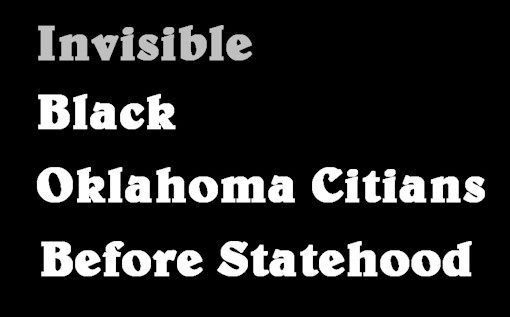
This post honors Black History Month with three stories about Invisible Black History in Oklahoma City before statehood, and largely tracks my presentation to RetroMetro OKC at the downtown library on February 17, 2014. A few additional materials and resources are provided here.
This post is still being constructed.
To view the videos below without enlargement, just click on the triangle in each video. To see videos in full-screen mode, click the full-screen icon as shown in the near-right icon (the red rectangle); adjust the volume with the far-right blue rectangled icon; both below:

Part 1: Introduction -- Why Is Pre-statehood Black History Invisible? The video for the Introduction is broken into two parts, for faster loading and quality purposes.
... Click here to read the full article and any comments ...
Was a convention hotel mentioned as a part of the MAPS 3 campaign? Part of the June 11, 2013, City Council discussion focused on that question during a presentation by the Alliance for Oklahoma City Economic Development. A truncated version of the discussion, focusing only on this question, appears below ...
For a few dollars more.
MORE THAN WHAT? That would be more than the $280 million (now $250 million) that those in charge of the MAPS 3 campaign said that it would cost to fund the convention center element of MAPS 3 ... around $50-$250 million dollars more ... that the city would need to spend for the MAPS 3 convention center project for it to be economically viable. In this context, "city", unfortunately, means the taxpayers of Oklahoma City. You can be sure that the mayor and city council members, as individuals, aren't going to pony up the cost of financing a convention center hotel, right?
The above video only contains relevant portions of the council meeting as to whether a convention hotel was mentioned during the MAPS 3 campaign. The complete discussion between Ms. O'Connor and the City Council is in the 22:43 minute clip below. The main components of the discussion begin at the following time-points ... use the slider to move to particular locations ...
| Cathy O'Connor ... | 0:13 | Credentials;
Tom Morsch ... | 12:20 | Pete White ... | 17:48 |
| Ed Shadid ... | 4:09;
12:20 | Meg Salyer ... | 15:48 | Larry McAtee &
Jeremy Stone ... | 19:00 |
| James Greiner ... | 11:20 | Patrick Ryan ... | 16:53;
18:48 | Motion & Vote ... | 21:20 |
Links Within This Article
Background Hotel History Biltmore Hotel
What Would Colcord Do? Urban Renewal Destruction Urban Renewal Aftermath
Exiting Hotels Pre-Maps 3 Chamber Viewpoint Thunder Interlude
MAPS 3 Begins The Chamber's Study Dark City
Hotel Not Mentioned Why Not? The Chamber's Hotel Quest
Why Did O'Connor Say What She Did?
BACKGROUND. In this period, it is helpful to understand that a convention center AND a convention hotel were not always linked together as they have evidently come to be linked today. I'll begin with the easiest part, the development of the city's downtown hoteliers.
A Glimpse At Downtown Hotel History. This by no means traces the history of Oklahoma City's downtown hotels and is only a peek at a part of it. Building and operating hotels involves a good bit of risk taking, and Oklahoma City's downtown hotel experience is abundantly steeped in both sides of that flipped coin, particularly concerning the frailty of downtown hotels when economic times are tough and public assistance in helping them survive was non-existent.
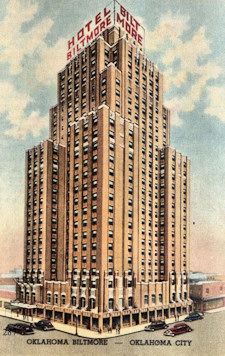 The Biltmore. Construction of a large downtown hotel finds a precedent with the Biltmore. With construction starts and stops before it was completed, the Biltmore was constructed between 1929 and 1932, it opening in March during that year, a year after the Great Depression finally hit Oklahoma City. It involved a monumental undertaking for private business leaders to get the project completed. A number of city capitalists played key roles in making this hotel a reality, including Charles F. Colcord, Martin Reinhart, Stanley Draper, J.F. Owen, Frank Buttram, Frank P. Johnson, W.E. Hightower, W.T. Hales, and W. R. Ramsey who built the 33-story Ramsey Tower (now City Place). The Biltmore. Construction of a large downtown hotel finds a precedent with the Biltmore. With construction starts and stops before it was completed, the Biltmore was constructed between 1929 and 1932, it opening in March during that year, a year after the Great Depression finally hit Oklahoma City. It involved a monumental undertaking for private business leaders to get the project completed. A number of city capitalists played key roles in making this hotel a reality, including Charles F. Colcord, Martin Reinhart, Stanley Draper, J.F. Owen, Frank Buttram, Frank P. Johnson, W.E. Hightower, W.T. Hales, and W. R. Ramsey who built the 33-story Ramsey Tower (now City Place).
About Johnson, it was said in a December 18, 1931, Oklahoman article on 1931's "Most Useful Citizen," that:
In nominating Johnson, C. Edgar Honnold, broker, wrote: * * * I believe it has been through his efforts that the First National building has been erected. It is certainly a great credit to any community, institution or individual. I believe it has been mostly through Mr. Johnson's efforts that the Biltmore hotel has actually been constructed and completed. ¶ Charles W. Gunter, chairman of the First National bank and Trust Co. executive committee, and W.R. Ramsey, oil man, also nominated Johnson for similar reasons. ¶ Gunter wrote: "I am convinced the Oklahoma Biltmore never would have been built had it not been for his (Johnson's) untiring efforts and leadership."
In a December 25, 1931, letter to the Oklahoman editor, J. K. Wells nominated Ramsey, noting, among other things,
He was largely responsible for bringing the Biltmore hotel to Oklahoma City and was the first to suggest the idea to the Biltmore interests of New York City.
As to Colcord, a March 6, 1932, Oklahoman reporter T.T. Johnson said,
Seventy-two years old, he is still straight and agile. His brown eyes are clear, his hair snow-white. He has proved his generosity and kindliness many times, and his record forbids that anyone ever should gainsay his qualifications as a forceful leader. During the three-year fight for the Biltmore, he arose early and worked late and vigorously. When the hotel seemed doomed, he snatched it from the brink of failure. He drove, drove, drove, into the pocket books of men who were able to pay. He has given Oklahoma City, Oklahoma and the southwest its finest hotel.
The project also involved a community effort. As late as early 1932, money was still needed for an operating fund for the hotel. In February 1932, stock sales were solicited from the public to create a $400,000 operating fund for the hotel.
When done, standing at 26 stories plus two basement levels, it was the 3rd tallest downtown building (although it claimed to be the tallest, perhaps because of its signage) and hosted 619 rooms. The Biltmore was then the largest hotel in the state and was said to be "the finest hotel in the Southwest." From 1932 until its destruction in 1977, no Oklahoma City hotel has matched its size or room capacity, and none have thereafter. To this day, the Biltmore remains as a shining example of what Oklahoma City's business leaders can do if they are willing to take the risk, even if dire economic challenges are presented while doing so.
In retrospect, what would Charles Colcord do today? One can but wonder what Charles F. Colcord might do if presented with today's challenge of building a convention hotel in Oklahoma City. Would he enlist investment by Oklahoma City's existing capitalists and take on the job of making it happen? Would he engage experts to determine the need? Would he involve the Alliance for Economic Development? Would he ask city taxpayers to share in the expense? Or would he just step up and see that it got done, just like he did with the Biltmore? These days, are any capitalist leaders around in the mold of Charles Colcord, whether he/she be a member of the Chamber or not?
Urban Renewal Hotel Destruction. Beyond the Biltmore, many of us remember the stark time that the Urban Renewal Authority demolished many downtown hotels in the 1960s-1970s, including the Huckins, Bristol/Threadgill, Kingkade, Egbert, Oklahoma Club/Tivoli Inn, Wells-Roberts, YWCA, and others, including, to be sure, the Biltmore.
Urban Renewal Aftermath. After those legacies were gone and the 1964-1993 Holiday Inn (last named the Commonwealth) at 520 W. Main closed its doors as a hotel, only the 1976 Sheraton Hotel (then called the Century Center) remained as a downtown hotel. In 1993 it, too, was in dire straits, it owing $167,000 in back property taxes for 1990, 1991 and 1992. As for the Skirvin, it closed its doors in 1988, not to be reopened as the Skirvin Hilton until 2007, 19 years later, and only after a huge effort by the city and private partners was the Skirvin restored to its former glory in 2007.
The City's Existing Downtown Hotel Stock. As described above, Oklahoma City's downtown hotel status had been abysmal for many years prior to the 2009 MAPS 3 election, even though it had improved by that time. At one point, after the former Holiday Inn (via various iterations) (about 200 rooms, 1964) finally closed as a hotel in 1993, Oklahoma City's downtown included only one hotel, the Sheraton, built in 1977, with 395 rooms. Hotels either completed or in construction as of July 2013 are shown below.
Between 2000 and 2008, six (6) hotels were added: the Marriott Renaissance (2000, 311 rooms); the Courtyard Marriott (2004, 225 rooms); the Colcord (2006, 108 rooms); and, not the least, the Skirvin Hilton (2007, 225 rooms). In Bricktown, the Hampton Inn (2006, 200 rooms) and Marriott Residence Inn (2006, 151 rooms), were also added.
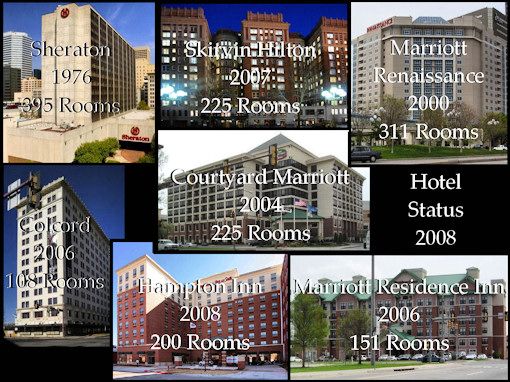
As of this writing in July 2013, four other hotels in Bricktown, Deep Deuce, and/or the Health Sciences area, are under construction and will open in 2013 or 2014: Hilton Inn & Homewood Suites (2013, 255 rooms); Aloft (2013, 130 suites); Holiday Inn Express (2014, 124 rooms); and Embassy Suites (2014, 194 rooms).

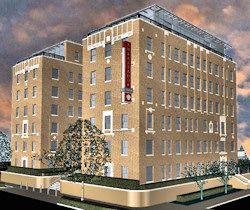 Yet another, a 54-room Midtown boutique hotel owned and being developed by Tulsa hotelier Paul Coury's company (which developed the Colcord Hotel in 2006) should be included. This outstanding project is presently converting the historic 1929 Osler physicians building at 1200 N. Walker into an Ambassador Hotel and it is scheduled for opening in December 2013. That date may be a bit ambitious — I'm guessing that an early 2014 opening is more likely. Yet another, a 54-room Midtown boutique hotel owned and being developed by Tulsa hotelier Paul Coury's company (which developed the Colcord Hotel in 2006) should be included. This outstanding project is presently converting the historic 1929 Osler physicians building at 1200 N. Walker into an Ambassador Hotel and it is scheduled for opening in December 2013. That date may be a bit ambitious — I'm guessing that an early 2014 opening is more likely.
Still other downtown hotels are in the proposal/approval stage, but I'm not including any of those projects in hotel room count here since doing so would involve some degree of speculation, and that includes a possible convention center hotel. Others not included are possible hotels that have been mentioned but remain speculative: Staybridge Suites (Bricktown, 131); East Bricktown (Bricktown, 150); Springhill Suites (Deep Deuce, 125); Patel's 2 potential projects in Bricktown at Lincoln & Sheridan (125 each).
As it stands today, the downtown stock of hotels, either built or being built, numbers twelve (12) and, unless I've misread something, that amounts to 2,372 downtown hotel rooms or suites which could bear some or a lot of risk should the city decide to finance, partially or completely, a convention hotel — which would compete against them — and remembering that "economic times" are historically cyclical and include both good times and bad.
Abbreviations below are: CBD=Central Business District; BT=Bricktown; DD=Deep Deuce; HSC=Health Sciences Center; MT=Midtown.
| # | Hotels Done or Under Construction | Rooms | CBD | BT | DD | HSC | MT |
| 1 | Sheraton (1976) | 395 | 395 | | | | |
| 2 | Marriott Renaissance (2000) | 311 | 311 | | | | |
| 3 | Courtyard Marriott (2004) | 225 | 225 | | | | |
| 4 | Colcord (2006) | 108 | 108 | | | | |
| 5 | Marriott Residence Inn (2006) | 151 | | 151 | | | |
| 6 | Skirvin Hilton (2007) | 225 | 225 | | | | |
| 7 | Hampton Inn (2008) | 200 | | 200 | | | |
| 8 | Hilton Inn & Homewood Suites (2013) | 255 | | 255 | | | |
| 9 | Aloft (2013) | 130 | | | 130 | | |
| 10 | Holiday Inn Express (2014) | 124 | | 124 | | | |
| 11 | Embassy Suites (2014) | 194 | | | | 194 | |
| 12 | Ambassador (2014) | 54 | | | | | 54 |
| Total Done or Under Construction | 2,372 | 1,264 | 730 | 130 | 194 | 54 |
Several articles by Oklahoman reporter Steve Lackmeyer have documented downtown hotel development. In his December 6, 2005, article, Lackmeyer reported on the appointment of Alan Sims as the convention center sales director. Lackmeyer said, "A decade ago, the Interstate 40/Meridian Avenue hotel corridor dominated the convention business. Since then, the downtown hotel market has recovered, with the number of hotels increasing from just one, the Sheraton, to seven with 1,400 rooms being opened over the next two years."
The Chamber's Pre-Maps 3 Point of View. Well before the 2009 MAPS 3 campaign and after several downtown hotels had been added (above), the Greater Oklahoma City Chamber of Commerce had been pushing for a new convention center, AND a new convention center hotel, although not always in tandem. In the December 2005 article referenced above, Lackmeyer said that, "[new convention sales director Alan] Sims said he thinks the city's Metropolitan Area Projects improvements downtown and at the State Fair Park, combined with new hotels, make the city ripe for a move into the second tier of the convention market. He said the city could still use a large convention hotel downtown — but can compete without one."
By Lackmeyer's January 18, 2007, article, "City chamber explores shift to tier two city," he reported,
A large conference hotel and additional meeting space may be the next mission downtown for the Greater Oklahoma City Chamber as it explores how to move from a tier three to a tier two convention city. ¶ The effort, announced by chairman Larry Nichols at Wednesday's State of the City address, will start with the chamber hiring a consultant next month.
"A new 1,000 room convention hotel is something we can certainly dream about," Nichols said. "The convention center is at capacity. If you try to book something in three weeks, won't find anything available." ¶ Nichols said the city has been told repeatedly it needs more than 1,000 hotel rooms to attract large conventions — and the opening of six new hotels over the past few years has put downtown's room count to more than 1,400. He noted more meeting space was added at the Cox Convention Center a decade ago as part of the Metropolitan Area Projects improvements back when downtown only had one hotel.
"Now we're on the other side, where we have more rooms but less convention space," Nichols said. "We've got to define what a tier two city needs in terms of facilities and hotel capacity. And if you look around, major tier two cities all have major conference hotels — 500 to 1,000 rooms, a convention headquarters — which we don't have."
* * *
Mayor Mick Cornet endorsed the chamber's study. ¶ A lot of people look at Oklahoma City and say, 'anything is possible.' We need to know if this center can be expanded or do we need to start over someplace else,' Cornett said." |
In a January 25, 2008, op-ed piece by Brett Hamm, then President of Downtown OKC Inc., he said,
|
What tools are needed for Oklahoma City's future? An expanded convention center? A convention hotel? A light rail system? How do residential, retail and Core to Shore fit into tomorrow's picture? And, what will it take to integrate thse new and vibrant districts? ¶ As we collaboratively work to answer these questions, our willingness to consistently assess available tools and implement new tools as needed is paramount. These past 15 years have shown that when we rise to this challenge we not only surprise other cities, but ourselves as well. |
Can you say, "These comments were a precursor to the MAPS 3 content?"
 2007-2008: A Funny Thing Happened On the Way to 2007-2008: A Funny Thing Happened On the Way to The Forum MAPS 3. MAPS 3 seemed to be on track for a vote sometime in 2008. But, when it developed in December 2007 that Seattle's ambivalence/incompetence/whatever in handling its own affairs made it evident that the SuperSonics could well move to Oklahoma City because of that, should the Oklahoma City voters agree to make improvements occur to the Ford Center and construct a training facility, potential MAPS 3 matters took the sideline. Acting quickly, Mayor Cornett took the lead in December 2007 to be the cheerleader in presenting a vote to the public to undertake the needed items through a "mini-MAPS" project for a penny sales tax for 15 months at a cost of $128 million beginning with the January 1, 2009, expiration of the MAPS For Kids sales tax in the same penny amount. One might call this development the "MAPS With No Name" or "MAPS For NBA." On March 4, 2008, voters eagerly assented to the projects by a vote of 44,849 to 27,564 (62% to 38%). The rest is history and the SuperSonics relocated to Oklahoma City, were renamed the Thunder, and there you have it — Oklahoma City's National Basketball Association team, right here in River City.
MAPS 3 — 2009. At long last, we arrive in 2009, the year of the MAPS 3 vote. Development of a MAPS 3 plan was sidelined during 2008 due to the Ford Center project, but in spring 2009, things got cookin'. MAPS 3 was ostensibly formulated during spring and summer 2009 — I say, "ostensibly," since it is clear that since at least 2007 a new convention center, as well as a a convention hotel, were projects favored by the Chamber and the Mayor — but not necessarily as parts of MAPS 3, per se. Recall also that Steve Lackmeyer's January 18, 2007, article, reported that the Chamber would hire a consultant the next month, February 2007, to evaluate the city's needs for a convention center, and that in the same article that Chamber president Larry Nichols spoke of the need for a 500 to 1,000 room convention hotel.
The Chamber's CSL Convention Study. The convention study referenced in Lackmeyer's 2007 article was doubtless the study by Conventions, Sports & Leisure, International, which was first publicly described (as far as I can locate) in Lackmeyer's March 11, 2009, article, "New convention center is priority, study finds." Doubtless, the study funded by the Chamber in February 2007 was completed well before its first public quasi-disclosure in March 2009.
"What do you mean, 'quasi-disclosure,'" you rightly ask? Even though the study was performed by CSL in 2007 and was likely completed during the same year, no mention was made of that study in the Oklahoman or other news sources before March 2009, and it has pretty much been a phantom study as far as the public is concerned. Even to this day, the study has not been released to the general public. It is foolhardy to doubt that it was not seen by the Mayor and at least some council members prior to its quasi-disclosure in March 2009 in an Oklahoman article by Steve Lackmeyer.
Lackmeyer's March 11, 2009, article said, in part:
Oklahoma City is at a crossroads in its quest to become a second-tier convention market, and a new study commissioned by the Greater Oklahoma City Chamber recommends building a $400 million convention center to ensure the city stays competitive.
The study by Conventions, Sports & Leisure International, suggests that replacing the 38-year old Cox Convention Center will cost $250 to $400 million.
Mayor Mick Cornett has suggested for the past two years that any MAPS 3 should include a new convention center as a priority project. That call is being joined by the Greater Oklahoma City Chamber.
"We believe the convention center plays a vital role in the development of the visitor industry and in the development of downtown," said David Thompson, chamber chairman.
"This study tells us clearly that our current center is not large enough, nor does it boast the amenities we need to be competitive. It is time for us to make an investment in this industry or recognize that we are slowly going out of business as far as conventions are concerned." |
Did reporter Lackmeyer have the full CSL study when writing the above March 11 article? He didn't say. $250 to $400 million for a convention center cuts a pretty wide swath. Was a Phase 1 and Phase 2 mentioned in the study? He didn't say.
One additional item should be mentioned about this March 11, 2009, article. In the article's sidebar, Lackmeyer wrote,
WHAT'S NEXT? >Consultants recommend construction of a new convention with between 200,000 and 300,000 square feet of exhibit space; between 50,000 and 75,000 square feet of meeting space; and between 30,000 and 50,000 square feet of ballroom space. * * *
* * *
Chamber President Roy Williams predicts planning for a new convention center will be complicated, and an opening would take six years if started today. Ideally, Williams said, a proposal should include a hotelier ready to commit to building a convention hotel as part of the project if approved by voters. Williams added the convention center and hotel should open at the same time. [Emphasis supplied] |
A reasonable inference, if not explicit suggestion, of Williams' comments just referenced is that a convention hotel, if one be built, would be not involve taxpayer support, but would instead be paid for by a hotelier ready to commit to building a hotel. At the least, if I've misconstrued Williams' comments, his remarks clearly differentiate between (a) a convention center which would be funded by the public as part of a then potential MAPS 3 proposal and (b) a convention hotel which would not be. At least, that's my reading.
In a separate March 11 Q&A Oklahoman article with the Mayor by Lackmeyer, we get more of a glimpse at, but not yet a complete picture, of the answers:
Q: The Greater Oklahoma City Chamber released a study Tuesday recommending construction of a $400 million convention center. How do you see this proposal moving forward?
A: First of all, the $400 million number you mentioned is if we pursued both a phase one and two. I think we are more focused on considering a phase one in the short term, which would cost closer to $250 million. * * * But the vehicle for funding this project would be a MAPS 3, and we as a community still have to decide that we want to proceed towards a MAPS 3 vote at the end of this year. If we do, a new convention center will strongly be considered as a project. |
Again, I wonder if Lackmeyer had the full report when writing the pair of March 11 articles.
About the CSL study, the main March 11 article continued by giving Roy Williams' (the chamber's CEO) take on the study:
|
Williams said Conventions, Sports & Leisure was chosen because of reputation and prior experience looking at Oklahoma City's convention market. ¶ Williams said the study is ongoing. The first phase included a comparison to cities Oklahoma City competes with for conventions, and a destination market analysis that considers the likelihood that the city can move up to the next tier with a new convention center. ¶ "The destination market analysis looks at other amenities you should have to attract visitors," Williams said. "It looks at the total component of visitor attractions." ¶ Williams quoted the consultants as saying Oklahoma City is assured increased business if it builds a new convention center.
|
"Phase one" ... "phase two" ... where do those phrases come from? They obviously relate to the CSL study, but, aside from Cathy O'Connor's comments in the June 11, 2013, city council discussion, wherein O'Connor said ...
| The convention center hotel project WAS [emphasis hers] mentioned as a part of the MAPS 3 campaign literature and campaign materials as a part of the Phase 1 development of a new convention center. |
... we are pretty much left to guess about the parameters of phases one and two in the CSL study and any possible mention of a convention hotel. During the MAPS 3 campaign, the CSL convention study received no mention all from March 11 until December 8, the day of the election itself.
In an un-authored December 8, 2009, "A closer look," article, on the day of the election, the Oklahoman said,
A study by the Greater Oklahoma City Chamber found the Cox Convention Center is too small to serve the city's convention needs in the coming decades.
* * *
A study commissioned by the chamber estimates the new convention center would triple the economic impact of the Cox Center, bringing nearly $80 million a year and 1,100 jobs to the local economy. |
What I've identified above contains the complete public record of any mention of the CSL study between March 11 and December 8, 2009. Other than the passing reference Roy Williams made to a convention hotel in Lackmeyer's March 11 article, no mention is made of a possible convention hotel.
Even after December 8, 2009, until today, the CSL study has received little mention in the press, even though the Oklahoman, or at least its leadership, as well as the Mayor and at least some council members, were obviously privy to it.
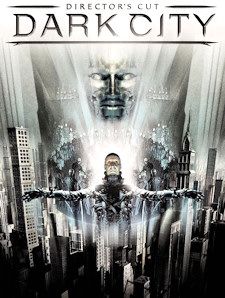 Dark City. This was a very dark period for investigative journalism at the Oklahoman, very dark. Recall these things: the Chamber itself guided the MAPS 3 campaign; the campaign was led by David Thompson, then the Chamber President; Thompson was also president of the OPUBCO Communications Group. Thompson or his staff held close reigns on what Oklahoman reporters were allowed to write about during the MAPS 3 campaign and, on at least one occasion that I am privy to, even changed a reporter's submitted MAPS 3 story to render it more MAPS 3 friendly than the article he originally wrote for publication. Dark City. This was a very dark period for investigative journalism at the Oklahoman, very dark. Recall these things: the Chamber itself guided the MAPS 3 campaign; the campaign was led by David Thompson, then the Chamber President; Thompson was also president of the OPUBCO Communications Group. Thompson or his staff held close reigns on what Oklahoman reporters were allowed to write about during the MAPS 3 campaign and, on at least one occasion that I am privy to, even changed a reporter's submitted MAPS 3 story to render it more MAPS 3 friendly than the article he originally wrote for publication.
During Thompson's regime as head of the MAPS 3 campaign, that Oklahoman reporter privately communicated with me by e-mail. The reporter, no longer with the Oklahoman, told me that a MAPS 3 article that he'd submitted for publication was substantially changed by his editor to make it more MAPS 3 friendly and that the changes were made without his knowledge or consent and even though the reported story continued to bear his byline.
In short, the Chamber, which had commissioned the study in February 2007, was fully aware of the study's content after its completion, probably in late 2007 but certainly by early 2008, and that the Chamber via David Thompson controlled what was said about the convention center, including the CSL study, during the entirety of the MAPS 3 campaign.
Hotel Not Mentioned. The Chamber's "Breaking Through" presentations/luncheons in October and November 2009 did not mention the study or a convention hotel. The city's website for MAPS 3 did not mention that a convention hotel would or might be needed for the convention center's viability.
Why then did the CSL study which was relied upon by the Chamber and the Mayor as being so important as a touchstone rationale as to why a convention center should be included in MAPS 3 receive absolutely no attention during the MAPS 3 campaign itself?
As of this writing, the Oklahoman has still not presented an article comprehensively describing the content of the CSL study. Fortunately, the city has a weekly newspaper, the Oklahoma Gazette, which sometimes fills in some of the gaps.
In a lengthy December 5, 2012, Oklahoma Gazette article by Clifton Adcock, some, but not all, of the CSL missing pieces were filled in. About the study, Adcock wrote,
The CS&L study almost has the air of legend to it — often referred to, but few have actually seen it.
Completed in February 2009, it details why the city needs more convention center space. Although it holds critical implications for public policy and the spending of taxpayer money, the report itself is not a public record.
Instead, it is kept by the Greater Oklahoma City Chamber of Commerce. The chamber recently provided Oklahoma Gazette with access to the study. A reporter was allowed to read it under supervision and take notes, but not to copy or photograph any of the materials. | |
That is a step in the right direction, at least. The article says that the report was completed in February 2009, notwithstanding that the Chamber engaged CSL to perform the study in February 2007. That fact leads one to wonder if an earlier CSL study also existed, or if the report was merely delayed to be in sync with the MAPS 3 campaign. Be that as it may, Adcock's report continues ...
"The rationale behind the study was we have a 40-year-old convention center that is not built to industry standards. If we're going to grow our convention business, what do we have to do?" said Roy Williams, president of the city chamber.
The report concluded that while the "practical maximum capacity" occupancy rate — the amount of sellable space being occupied per year — is around 70 percent, the Cox Convention Center had an average of only 26 percent occupancy between 2003 and 2009. ¶ The current usable space is too small and not high-quality enough to attract many large-scale conventions, according to the study. CS&L recommended a center with at least 285,000 square feet of usable space to better compete with peer cities.
This part of the study is often cited by officials and boosters as justification for a new convention center. ¶ But another reason for the low occupancy levels, the study continues, is the fact that management of the Cox Convention Center is shared by two companies: SMG, which manages and leases out arena and event space; and Renaissance Hotel, which manages and leases out the center’s ballroom and meeting rooms.
In the late 1990s, city leaders had used management of some convention center space to help entice the Renaissance to locate downtown. ¶ But that bifurcated management situation "is highly unusual in the industry and likely impacts overall ability to book events" at the convention center, the CS&L report says. "For any future hotel development, we strongly recommend that a hotel operator not be given rights to book or operate space in the convention center." | |
That's all good, but several unanswered questions remain:
- Did CSL do one, or more than one, convention studies for the Chamber?
- If only one, since the Chamber commissioned the CSL study in February 2007, why was its "release" (a euphemism, I think) not made until March 2009?
- Exactly what does "phase one" and "phase two" mean?
- Was ANY mention made of a convention hotel during the MAPS 3 campaign?
- When, if ever, will the Chamber come out of the closet and let the public see the study or studies?
- Did ANY study by the Chamber make mention of the need for a convention hotel?
The bottom line is that the public does not know the answers to the first 3 questions. Neither do I.
As to the fourth, we know that the answer is, "No. A convention hotel was not mentioned during the MAPS 3 campaign." Notwithstanding Cathy O'Connor's statements to the City Council on June 11, 2013, neither during the Chamber's "Breaking Through" luncheons, through other campaign publicity, or otherwise in the media was a convention hotel ever mentioned, as council members Shadid and Greiner said on June 11, 2013. O'Connor was flat wrong.
Council member McAtee was also wrong in suggesting that Shadid and Greiner had "slanted" their comments, if "slanted" means not being truthful. If any council member can rightly be charged with being untruthful in the June 11 discussion, it is Larry McAtee and not the other two guys.
Why wasn't a convention hotel mentioned in the MAPS 3 campaign? My answer and opinion is that David Thompson, who chaired the campaign and the other campaign cheerleaders, including the Mayor, didn't want it to be. See Dark City, above. Most probably, given the unpopularity of the MAPS 3 project, those leaders feared that its mention might doom the MAPS 3 vote, should the public become aware that yet another city taxpayer expense might become involved with the convention center than was involved in the MAPS 3 tax, itself.
My opinion is that Thompson, the Chamber, the Mayor, and all those privy to the CSL study, deliberately concealed from the public that a convention hotel would also be needed for the success of the MAPS 3 convention center. With publicity about the possible need for a convention hotel, and the potential of additional public funding beyond MAPS 3's amounts, MAPS 3 might well have been doomed to failure. As it was, without that information being available to the public, MAPS 3 passed by a vote of 54% to 46%. Would disclosure of the potential hotel expense have mattered in the vote tally? My guess is that, probably, it would, since the convention center was popular with the Chamber but not by the voters.
As to question 5, who can say? Maybe the Chamber will discontinue its peek-a-boo position concerning the CSL study (studies) and will at long last step out of the closet.
As to the 6th, we don't know the answer to that question with certainty, but we do have considerable information which indicates what the Chamber wanted.
The Chamber's Quest For A Convention Hotel. At least by January 18, 2007, we know that the Chamber made its views known in a Lackmeyer article of the same date. In that article, "City chamber explores shift to tier two city," he reported,
A large conference hotel and additional meeting space may be the next mission downtown for the Greater Oklahoma City Chamber as it explores how to move from a tier three to a tier two convention city. ¶ The effort, announced by chairman Larry Nichols at Wednesday's State of the City address, will start with the chamber hiring a consultant next month.
"A new 1,000 room convention hotel is something we can certainly dream about," Nichols said. "The convention center is at capacity. If you try to book something in three weeks, won't find anything available." ¶ Nichols said the city has been told repeatedly it needs more than 1,000 hotel rooms to attract large conventions — and the opening of six new hotels over the past few years has put downtown's room count to more than 1,400. He noted more meeting space was added at the Cox Convention Center a decade ago as part of the Metropolitan Area Projects improvements back when downtown only had one hotel.
"Now we're on the other side, where we have more rooms but less convention space," Nichols said. "We've got to define what a tier two city needs in terms of facilities and hotel capacity. And if you look around, major tier two cities all have major conference hotels — 500 to 1,000 rooms, a convention headquarters — which we don't have." [Emphasis supplied] |
Hey, wait a minute! This article, mentioning the Chamber's wish list for a 1,000 (or 500-1,000) room convention hotel, was written on the eve of the Chamber's commissioning of the CSL study, the Chamber firing its salvos favoring a convention hotel. Put this info into your pipe and smoke it as the CSL study was about to begin.
However, like Ron Popeil says, "BUT WAIT!" so lets hold up on that smoke for a moment. Another article, a January 25, 2008, op-ed piece published in the Oklahoman written by Brett Hamm, President of Downtown OKC Inc. (a component of the Chamber), Hamm said,
|
What tools are needed for Oklahoma City's future? An expanded convention center? A convention hotel? * * * [Emphasis supplied] |
By the time the January 2008 op-ed piece by Hamm was written, the CSL study commissioned by the Chamber in February 2007 would presumably have been done.
Now, finally, put the above into your pipe, also, and then proceed to smoke. It is difficult to doubt that a Chamber priority since at least 2007 has been the building of a convention hotel in downtown Oklahoma City. It is just as difficult to doubt that the CSL study which the Chamber initiated with CSL in 2007 did not mention a convention hotel.
Why Did O'Connor Say What She Did? This one's a bit hard to figure. If Ed Shadid had wanted or needed a foil who would present, as the antagonist to the protagonist, a springboard to his more substantive comments about a convention hotel, it would be hard to imagine a better one than O'Connor presented with her opening remarks on June 11, 2013.
Why would O'Connor have made such a huge blunder? Perhaps it was because in her own mind she had melded and blurred the content of the MAPS 3 campaign, September 2009-December 2009, with the content of the CSL study, finished between 2007-2009, when she made her remarks on June 11, 2013, 3½ years after the MAPS 3 vote ...
|
The convention center hotel project WAS [emphasis hers] mentioned as a part of the MAPS 3 campaign literature and campaign materials as a part of the Phase 1 development of a new convention center. |
O'Connor's completely inaccurate and false misrepresentation of history is perhaps due to (1) her ignorance or forgetfulness of what publicly transpired during the MAPS 3 campaign, and/or (2) her familiarity as an insider who was privy to the Chamber's CLS study (or studies). She may have simply confused the public campaign with the Chamber's private study and made no distinction between the two. Doubtless it was not her intention to be Shadid's foil in making the inaccurate statement that she made. Regardless, in her public words on June 11, she made a wholly historical blunder, and one which rather nicely played into the hands of and setting up Ed Shadid's rejoinder and his other comments, which followed her own presentation. Hearing O'Connor's remarks, Shadid may have been thinking to himself and inwardly rolling his eyeballs upward while sitting on the City Council's horseshoe, saying, "Thank you, god."
This post is nearly done but more will shortly follow.
Go To Top
... Click here to read the full article and any comments ...
|
 Very sad news ... Terry L. Griffith, Oklahoma City historian and writer of three basic books on Oklahoma City's history, died on Christmas Day 2014.
Very sad news ... Terry L. Griffith, Oklahoma City historian and writer of three basic books on Oklahoma City's history, died on Christmas Day 2014.






 Case #2 — United States v. David Hall, Chapters 12-24.
Case #2 — United States v. David Hall, Chapters 12-24.
 Case #3 — The Girl Scout Murders, Chapters 25-37.
Case #3 — The Girl Scout Murders, Chapters 25-37.

 Case #4 — The Karen Silkwood Case, Chapters 38-49.
Case #4 — The Karen Silkwood Case, Chapters 38-49.

 A subchapter title in this case might have been Verna Rae Stafford vs. Roger Dale Stafford, husband and wife. Roger had apparently counted on her not being able to testify against him, but a change in Oklahoma law was interpreted by the courts as allowing her testimony.
A subchapter title in this case might have been Verna Rae Stafford vs. Roger Dale Stafford, husband and wife. Roger had apparently counted on her not being able to testify against him, but a change in Oklahoma law was interpreted by the courts as allowing her testimony.
 The author reports on Roger Dale being interviewed/questioned by Arthur Linville, OSBI agent, as follows:
The author reports on Roger Dale being interviewed/questioned by Arthur Linville, OSBI agent, as follows:



 A popular bumper sticker read "Vote for the crook, it's important", and that's what the people of Louisiana did. Although, it may not be quite as dramatic, we have some Republican Primaries where our choices are almost as unpalatable as the Louisiana governor's race. The problem is — that's all we've got. It's not a question of who you would like to have in office but simply a question of which one of these bozos would do the least harm. With that in mind, here is the Common Sense Election Special.
A popular bumper sticker read "Vote for the crook, it's important", and that's what the people of Louisiana did. Although, it may not be quite as dramatic, we have some Republican Primaries where our choices are almost as unpalatable as the Louisiana governor's race. The problem is — that's all we've got. It's not a question of who you would like to have in office but simply a question of which one of these bozos would do the least harm. With that in mind, here is the Common Sense Election Special.
 In the race for Tom Coburn's vacated United States Senate seat, there are three significant Republican candidates who are far right, further right and, furthest right. Congressman James Langford is by any measure a conservative on every issue but, he isn't pure enough for T.W. Shannon who also doesn't quite measure up to Tea Party standards, according to Randy Brogdon. Recently, the three candidates took part in a faux debate before a conservative forum. From the looks of the crowd, the gathering was composed almost entirely of older white people. One of the first questions asked was the position of each candidate on the U.N. All three quickly agreed that the U.S. should get out of the UN. Brogdon, in order to distinguish himself as the rightest of the right, also opined that the U.S. should throw the UN out of the country. These guys are living in another century, yet one of them will be your United States Senator, whether you like it or not. It moves me to shed a crocodile tear for Tom Coburn, an intelligent, independent and thoroughly committed public servant who is unfortunately stepping down from the Senate.
In the race for Tom Coburn's vacated United States Senate seat, there are three significant Republican candidates who are far right, further right and, furthest right. Congressman James Langford is by any measure a conservative on every issue but, he isn't pure enough for T.W. Shannon who also doesn't quite measure up to Tea Party standards, according to Randy Brogdon. Recently, the three candidates took part in a faux debate before a conservative forum. From the looks of the crowd, the gathering was composed almost entirely of older white people. One of the first questions asked was the position of each candidate on the U.N. All three quickly agreed that the U.S. should get out of the UN. Brogdon, in order to distinguish himself as the rightest of the right, also opined that the U.S. should throw the UN out of the country. These guys are living in another century, yet one of them will be your United States Senator, whether you like it or not. It moves me to shed a crocodile tear for Tom Coburn, an intelligent, independent and thoroughly committed public servant who is unfortunately stepping down from the Senate.
 Has the gene pool run out in Oklahoma? What ever happened to leaders like Bob Kerr, Howard Edmonson, Fred Harris, Henry Bellmon, David Boren and Frank Keating? No matter what their politics, these men were all intelligent, informed leaders, willing to address important issues. It is depressing that we have apparently dumbed down our state to the point where candidates like Langford, Shannon and Brogdon are the best we have to offer. But the Legislature wants to be sure we don't make third graders actually learn to read. It might threaten the future of the political class.
Has the gene pool run out in Oklahoma? What ever happened to leaders like Bob Kerr, Howard Edmonson, Fred Harris, Henry Bellmon, David Boren and Frank Keating? No matter what their politics, these men were all intelligent, informed leaders, willing to address important issues. It is depressing that we have apparently dumbed down our state to the point where candidates like Langford, Shannon and Brogdon are the best we have to offer. But the Legislature wants to be sure we don't make third graders actually learn to read. It might threaten the future of the political class.
 At least, in the governor's race, we have a choice. Chad Moody is a pure Libertarian, running as a Republican. A criminal lawyer who has personally observed the failure of the War on Drugs, Moody is advocating the legalization of marijuana. He also opposes the government's interference in the rights of citizens. As his campaign sign states "Forget faith, family and, freedom (Fallin's Slogan) and vote for God, grass and guns." Common Sense urges you to vote for Chad Moody, our only endorsement in this lackluster primary election.
At least, in the governor's race, we have a choice. Chad Moody is a pure Libertarian, running as a Republican. A criminal lawyer who has personally observed the failure of the War on Drugs, Moody is advocating the legalization of marijuana. He also opposes the government's interference in the rights of citizens. As his campaign sign states "Forget faith, family and, freedom (Fallin's Slogan) and vote for God, grass and guns." Common Sense urges you to vote for Chad Moody, our only endorsement in this lackluster primary election.
 A few weeks ago, the leaders of three of Oklahoma's biggest oil companies gave the legislature its orders as to exactly what to do regarding the extension of a tax break from the gross production tax. The Legislature then fell in line like so many sheep, only slightly modifying the industry's mandate and passed a bill permanently installing a tax subsidy. The historic tax rate of 7 percent was changed to 2 percent for the first 36 months of production on all wells. It had been temporarily 1 percent for 48 months on horizontal wells, ostensibly to encourage drilling. The increase from 1 percent to 2 percent is chump change to the oil companies, but means all of us other chumps will have to pick up the difference to pay for government services like the highways the oil business drives their trucks on and the schools their employee's children attend.
A few weeks ago, the leaders of three of Oklahoma's biggest oil companies gave the legislature its orders as to exactly what to do regarding the extension of a tax break from the gross production tax. The Legislature then fell in line like so many sheep, only slightly modifying the industry's mandate and passed a bill permanently installing a tax subsidy. The historic tax rate of 7 percent was changed to 2 percent for the first 36 months of production on all wells. It had been temporarily 1 percent for 48 months on horizontal wells, ostensibly to encourage drilling. The increase from 1 percent to 2 percent is chump change to the oil companies, but means all of us other chumps will have to pick up the difference to pay for government services like the highways the oil business drives their trucks on and the schools their employee's children attend.
 Kent's words have far greater elegance than mine could ever have, and the sad truth is that we — citizens who have or claim to have some measure of sanity — have ourselves at least partially to blame for the ascendency of those who have become leaders in the Republican party today — and the same is true for Democrats, Independents, Libertarians, whoever, that sees a menace encamped on the horizon yet takes no action until the menace-takeover is already accomplished. Like Yoda said, "Blind we are if creation of this clone army we could not see."
Kent's words have far greater elegance than mine could ever have, and the sad truth is that we — citizens who have or claim to have some measure of sanity — have ourselves at least partially to blame for the ascendency of those who have become leaders in the Republican party today — and the same is true for Democrats, Independents, Libertarians, whoever, that sees a menace encamped on the horizon yet takes no action until the menace-takeover is already accomplished. Like Yoda said, "Blind we are if creation of this clone army we could not see."






 2007-2008: A Funny Thing Happened On the Way to
2007-2008: A Funny Thing Happened On the Way to 












